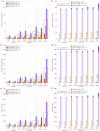The impact of school reopening on the spread of COVID-19 in England
- PMID: 34053259
- PMCID: PMC8165595
- DOI: 10.1098/rstb.2020.0261
The impact of school reopening on the spread of COVID-19 in England
Abstract
By mid-May 2020, cases of COVID-19 in the UK had been declining for over a month; a multi-phase emergence from lockdown was planned, including a scheduled partial reopening of schools on 1 June 2020. Although evidence suggests that children generally display mild symptoms, the size of the school-age population means the total impact of reopening schools is unclear. Here, we present work from mid-May 2020 that focused on the imminent opening of schools and consider what these results imply for future policy. We compared eight strategies for reopening primary and secondary schools in England. Modifying a transmission model fitted to UK SARS-CoV-2 data, we assessed how reopening schools affects contact patterns, anticipated secondary infections and the relative change in the reproduction number, R. We determined the associated public health impact and its sensitivity to changes in social distancing within the wider community. We predicted that reopening schools with half-sized classes or focused on younger children was unlikely to push R above one. Older children generally have more social contacts, so reopening secondary schools results in more cases than reopening primary schools, while reopening both could have pushed R above one in some regions. Reductions in community social distancing were found to outweigh and exacerbate any impacts of reopening. In particular, opening schools when the reproduction number R is already above one generates the largest increase in cases. Our work indicates that while any school reopening will result in increased mixing and infection amongst children and the wider population, reopening schools alone in June 2020 was unlikely to push R above one. Ultimately, reopening decisions are a difficult trade-off between epidemiological consequences and the emotional, educational and developmental needs of children. Into the future, there are difficult questions about what controls can be instigated such that schools can remain open if cases increase. This article is part of the theme issue 'Modelling that shaped the early COVID-19 pandemic response in the UK'.
Keywords: COVID-19; SARS-CoV-2; deterministic model; mathematical modelling; reopening schools.
Figures




Similar articles
-
Determining the optimal strategy for reopening schools, the impact of test and trace interventions, and the risk of occurrence of a second COVID-19 epidemic wave in the UK: a modelling study.Lancet Child Adolesc Health. 2020 Nov;4(11):817-827. doi: 10.1016/S2352-4642(20)30250-9. Epub 2020 Aug 3. Lancet Child Adolesc Health. 2020. PMID: 32758453 Free PMC article.
-
Mapping social distancing measures to the reproduction number for COVID-19.Philos Trans R Soc Lond B Biol Sci. 2021 Jul 19;376(1829):20200276. doi: 10.1098/rstb.2020.0276. Epub 2021 May 31. Philos Trans R Soc Lond B Biol Sci. 2021. PMID: 34053268 Free PMC article.
-
SARS-CoV-2 infections in children following the full re-opening of schools and the impact of national lockdown: Prospective, national observational cohort surveillance, July-December 2020, England.J Infect. 2021 Apr;82(4):67-74. doi: 10.1016/j.jinf.2021.02.022. Epub 2021 Feb 25. J Infect. 2021. PMID: 33639175 Free PMC article.
-
Quarantine alone or in combination with other public health measures to control COVID-19: a rapid review.Cochrane Database Syst Rev. 2020 Sep 15;9(9):CD013574. doi: 10.1002/14651858.CD013574.pub2. Cochrane Database Syst Rev. 2020. PMID: 33959956 Free PMC article.
-
Measures implemented in the school setting to contain the COVID-19 pandemic: a scoping review.Cochrane Database Syst Rev. 2020 Dec 17;12(12):CD013812. doi: 10.1002/14651858.CD013812. Cochrane Database Syst Rev. 2020. PMID: 33331665 Free PMC article.
Cited by
-
Impacts of K-12 school reopening on the COVID-19 epidemic in Indiana, USA.Epidemics. 2021 Dec;37:100487. doi: 10.1016/j.epidem.2021.100487. Epub 2021 Aug 16. Epidemics. 2021. PMID: 34425301 Free PMC article.
-
Measures implemented in the school setting to contain the COVID-19 pandemic.Cochrane Database Syst Rev. 2022 Jan 17;1(1):CD015029. doi: 10.1002/14651858.CD015029. Cochrane Database Syst Rev. 2022. Update in: Cochrane Database Syst Rev. 2024 May 2;5:CD015029. doi: 10.1002/14651858.CD015029.pub2. PMID: 35037252 Free PMC article. Updated.
-
The COVID-19 Sentinel Schools Network of Catalonia (CSSNC) project: Associated factors to prevalence and incidence of SARS-CoV-2 infection in educational settings during the 2020-2021 academic year.PLoS One. 2022 Nov 17;17(11):e0277764. doi: 10.1371/journal.pone.0277764. eCollection 2022. PLoS One. 2022. PMID: 36395191 Free PMC article.
-
The impacts of SARS-CoV-2 vaccine dose separation and targeting on the COVID-19 epidemic in England.Nat Commun. 2023 Feb 10;14(1):740. doi: 10.1038/s41467-023-35943-0. Nat Commun. 2023. PMID: 36765050 Free PMC article.
-
Turkey's transition to face-to-face schooling during the COVID-19 pandemic.Turk J Med Sci. 2022 Jun;52(3):529-540. doi: 10.55730/1300-0144.5343. Epub 2022 Jun 16. Turk J Med Sci. 2022. PMID: 36326323 Free PMC article.
References
-
- Forbes MB, Mehta K, Kumar K, Lu J, Le Saux N, Sampson M, Robinson J. 2020. COVID-19 infection in children: estimating pediatric morbidity and mortality. medRxiv (10.1101/2020.05.05.20091751) - DOI
-
- NHS England. 2020. COVID-19 total announced deaths 27 May 2020. https://www.england.nhs.uk/statistics/wp-content/uploads/sites/2/2020/05... [Online] (accessed 23 June 2020).
Publication types
MeSH terms
Grants and funding
LinkOut - more resources
Full Text Sources
Other Literature Sources
Medical
Miscellaneous

